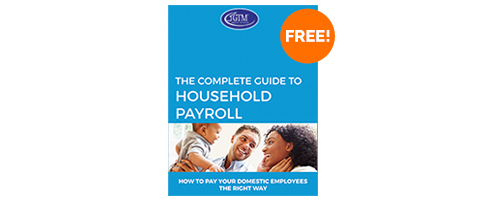
Individual Coverage Health Reimbursement Arrangement (ICHRA)
An Individual Coverage Health Reimbursement Arrangement (ICHRA) may appeal to household employers who wish to provide tax-free health benefits to their employees.
ICHRAs are like QSEHRAs (Qualified Small Employer Health Reimbursement Arrangement) as they are both employer-funded Health Reimbursement Arrangements (HRAs) that reimburse employees tax-free for health insurance premiums and/or medical expenses. The money contributed by a family to an ICHRA is also not subject to employer taxes.
The major difference between the two options is that there are no annual contribution limits with an ICHRA while QSEHRAs are restricted to a set amount each year.
A family can provide an ICHRA to their employees if they don’t already offer a QSEHRA or EBHRA. They also can’t provide a traditional group health insurance plan as well as an ICHRA at the same time.
With an ICHRA, employees pay for their individual health insurance premiums and/or medical expenses and then submit receipts for reimbursement from their employer.
Qualified medical expenses can include:
- annual physical exams
- doctor visits
- co-pays
- prescriptions
- dental treatments
- vision care
- inpatient hospital services
- medical equipment
An employer can select which expenses qualify so all expenses listed may not be reimbursable. For example, an employer can choose to only reimburse prescriptions through the ICHRA.
How an ICHRA Works
The family will need to set up “plan documents” that define the plan. The licensed insurance brokers at GTM Payroll Services can handle a plan set up for you.
- Employers decide whether to reimburse insurance premiums and/or qualified medical expenses and establish reimbursement limits (no limit on this amount).
- Employees purchase their qualified, individual health insurance coverage.
- Employees then submit claims for reimbursement (either for insurance premiums, medical expenses, or both depending on how the employer set up the ICHRA)
- Employers reimburse employees for valid claims. Reimbursements are tax-free to the employee.
- Employers report ICHRA reimbursements on the employee’s Form W-2.
Employee Requirements
An employee must show proof of existing, qualified health insurance coverage before they can receive reimbursements. If the employee loses or drops coverage at any point, then they are no longer able to claim reimbursements through an ICHRA.
If an employee doesn’t have health insurance, they will have a special enrollment period of 60 days from the time their employer offers an ICHRA to buy a plan. This means an employer can set up a plan at any point during the year and not wait for an employee to purchase health insurance through an open enrollment period.
For a health plan to be considered “qualified,” it must meet two primary requirements:
- Have no annual or lifetime limits
- Cover preventive health services with no cost-sharing
An employee isn’t allowed to use an ICHRA to pay for coverage while on their spouse’s group health insurance plan. However, if the spouse purchased coverage through the individual marketplace, then the employee can submit the family premium rate for reimbursement through an ICHRA.
Major plan types that will work with an ICHRA:
- Individual major medical plans (privately purchased or through the exchange)
- Catastrophic plans (limited to under age 30 or qualify for a hardship exemption)
- Medicare Part A + B or Part C
- Student health insurance
Plans that are not allowed with an ICHRA:
- Short-term limited-duration insurance
- Health care sharing ministries
- Fixed indemnity plans
- Excepted benefits coverage only (such as vision or dental)
- Association health plans
- Multiple employer welfare arrangements
- TRICARE
It’s important to note that an employer reimbursement will reduce or remove any government subsidies the employee may receive to help pay for their health insurance.
Throughout the year, an employee’s unused funds accrue. If an employee doesn’t use all their reimbursement funds, the employer can simply keep that money and reset the contribution limit for the following year. Employers also have the option to allow unused funds to carry over into the next year.
Employees of the World Bank and other government organizations who are responsible for their G-5 domestic worker’s health insurance may find the ICHRA to be a good option to help fulfill this obligation.
Health Insurance & Benefits Options Comparison Chart
This chart will help you compare the various plans and select one that will best meet the needs of your nanny. These are contribution rates for 2024.
| FSA | HRA | HSA | QSEHRA | ICHRA | POP | |
| Employer funded | ||||||
| Employer tax savings | ||||||
| Employee funded | ||||||
| Employee tax savings | ||||||
| Covers out-of-pocket expenses | ||||||
| Covers insurance premiums | ||||||
| Used to purchase health insurance | ||||||
| Contribution limits | $3,200 | No limit | $4,150 single $8,300 family |
$6,150 single $12,450 family |
No limit | No limit |
| Pairings | N/A | Group plan | High-deductible plan | Individual plans | N/A | Group plan |
| Coverage restrictions | None | Must cover at least two employees | None | None | None | None |
Get Started
Through our affiliate GTM Insurance Agency, setting up an ICHRA is easy and straightforward. Our insurance team will guide you through the entire process. Call (800) 929-9213 for more information or to get started.
Want more information? Download Individual Coverage HRAs – Paying Individual Insurance Premiums.
Household Employee Benefits & Insurance
- Health Insurance
- Dental & Vision Benefits
- Small Employer HRAs (QSEHRA)
- Individual Coverage HRAs (ICHRA)
- Health Reimbursement Arrangements (HRA)
- Flexible Spending Accounts (FSA)
- Retirement Plan
- Workers' Compensation Insurance
- Travel Insurance
- Employee Dishonesty Insurance
- Additional Insurance Options
Talk to an Expert
Our employee benefits experts are available to discuss your needs and help you get started with a Health Reimbursement Arrangement or other benefits.



